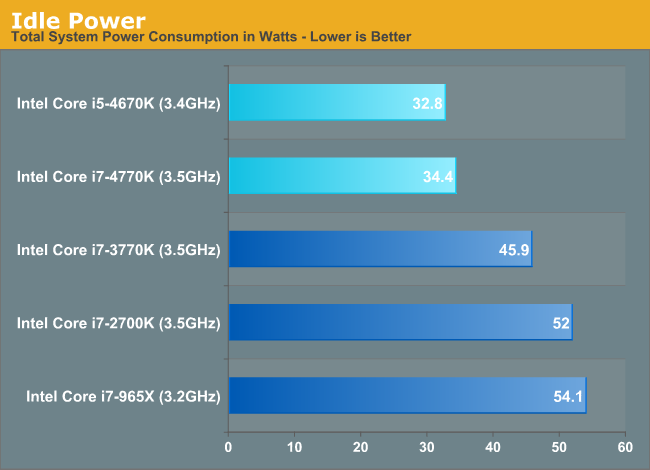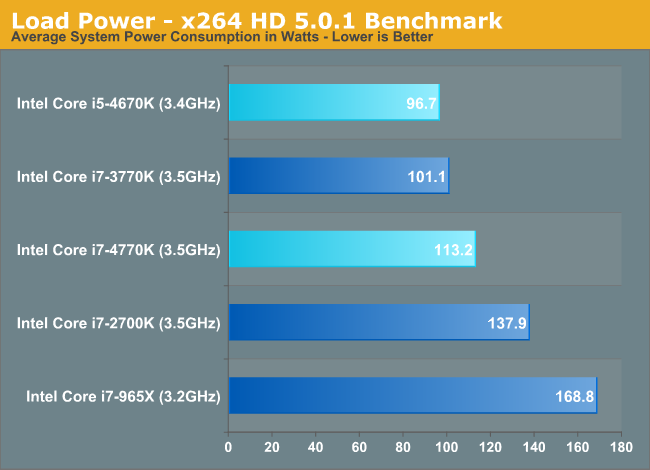The Haswell Review: Intel Core i7-4770K & i5-4670K Tested
by Anand Lal Shimpi on June 1, 2013 10:00 AM ESTPower Improvements
Although Haswell’s platform power is expected to drop considerably in mobile, particularly with Haswell U and Y SKUs (Ultrabooks and ultrathins/tablets), there are benefits to desktop Haswell parts as well.
There’s more fine grained power gating, lower chipset power and the CPU cores can transition between power states about 25% quicker than in Ivy Bridge - allowing the power control unit to be more aggressive in selecting lower power modes. We’ve also seen considerable improvements on lowering platform power consumption at the motherboard level as well. Using ASUS’ Z77 Deluxe and Z87 Deluxe motherboards for the Haswell, Ivy and Sandy Bridge CPUs, I measured significant improvements in idle power consumption:

These savings are beyond what I’d expect from Haswell alone. Intel isn’t the only one looking to make things as best as can be in the absence of any low hanging fruit. The motherboard makers are aggressively polishing their designs in order to grow their marketshare in a very difficult environment.
Under load, there’s no escaping the fact that Haswell can burn more power in pursuit of higher performance:

Here I’m showing an 11.8% increase in power consumption, and in this particular test the Core i7-4770K is 13% faster than the i7-3770K. Power consumption goes up, but so does performance per watt.
The other big part of the Haswell power story is what Intel is calling FIVR: Haswell’s Fully Integrated Voltage Regulator. Through a combination of on-die and on-package circuitry (mostly inductors on-package), Haswell assumes responsibility of distributing voltages to individual blocks and controllers (e.g. PCIe controller, memory controller, processor graphics, etc...). With FIVR, it’s easy to implement tons of voltage rails - which is why Intel doubled the number of internal voltage rails. With more independent voltage rails, there’s more fine grained control over the power delivered to various blocks of Haswell.
Thanks to a relatively high input voltage (on the order of 1.8V), it’s possible to generate quite a bit of current on-package and efficiently distribute power to all areas of the chip. Voltage ramps are 5 - 10x quicker with FIVR than with a traditional on-board voltage regulator implementation.
In order to ensure broad compatibility with memory types, there’s a second input voltage for DRAM as well.
FIVR also comes with a reduction in board area and component cost. I don’t suppose this is going to be a huge deal for desktops (admittedly the space and cost savings are basically non-existent), but it’ll mean a lot for mobile.
No S0ix for Desktop
You’ll notice that I didn’t mention any of the aggressive platform power optimizations in my sections on Haswell power management, that’s because they pretty much don’t apply here. The new active idle (S0ix) states are not supported by any of the desktop SKUs. It’s only the forthcoming Y and U series parts that support S0ix.










210 Comments
View All Comments
bji - Monday, June 3, 2013 - link
+10 false dichotomy. Look it up.kenjiwing - Saturday, June 1, 2013 - link
Any reviews comparing this gen to a 980x??Ryan Smith - Saturday, June 1, 2013 - link
It's available in Bench.http://www.anandtech.com/bench/Product/836?vs=142
owikh84 - Saturday, June 1, 2013 - link
4560K??? Not 4770K & 4670K?karasaj - Saturday, June 1, 2013 - link
4670K is the Haswell equivalent of a 3570K.hellcats - Saturday, June 1, 2013 - link
I read with some concern that the TSX instructions aren't going to be available on all SKUs. This is the main thing that I've been looking forward to on Haswell! Not providing the capability across the family is reminiscent of the 486SX/DX debacle. TSX could be huge for game physics as it would allow for far more consistent scaling. I know it is supposed to be backwards compatible, but what's the point of coding to it if it isn't always there?zanon - Saturday, June 1, 2013 - link
Agreed, TSX is one of the most interesting parts of Haswell so I'm sorry not to see it get more discussion. And as you say (and like with VT-d or other tech) I think Intel is being stupid and self-defeating by trying to make it an artificial differentiator. Unlike general basics of a chip such as clock rate, cache, hyperthreading or raw execution resources these sorts of features are only as valuable as the software that's coded for them, and nothing kills adoption amongst developers like "well maybe it'll be there but maybe not." If they can't depend on it, then it's not worth spending much extra time with and tremendously limits what it can be used for. That principal shows up over and over, it's why consoles can typically hold their own for so long. Even though on paper they get creamed, in reality developers are actually able to aim for 100% usage of all resources because there will never be any question about what is available.For features like this Intel should aim for as broad adoption as possible, or what's the point? They can differentiate just fine with pure performance, power, and physical properties. Disappointing as always.
penguin42 - Saturday, June 1, 2013 - link
Agreed! I'd also be interested in seeing performance comparisons with a transactionally optimised piece of code.Johnmcl7 - Saturday, June 1, 2013 - link
Definitely, I was a bit puzzled reading the review to find barely a mention of TSX when I thought it was meant to be one of the ground breaking new features on Haswell. Even if there was only a synthetic benchmark for now it would be extremely interesting to see if it works anything like as well as promised.John
bji - Sunday, June 2, 2013 - link
TSX is so esoteric in its applicability that I think you'd be very hard pressed to a) find a benchmark that could actually exercise it in a meaningful way and b) have any expectation that this benchmark would translate into any actual perceived performance gain in any application run by 99.999% of users.In other words - TSX is only going to help performance in some very rare and obscure types of software that "normal" users will never even come close to using, let alone caring about the performance of.
However I am intruiged by your speculation that TSX will be beneficial for physics simulation, which I guess could translate to perceivable performance increases for software that end users might actually use in the form of game physics. I found a paper that described techniques for using transactional memory to improve performance for physics simulation but it only found a 27% performance increase, which is not exactly earth shattering (I wouldn't call it "huge for game physics" personally).